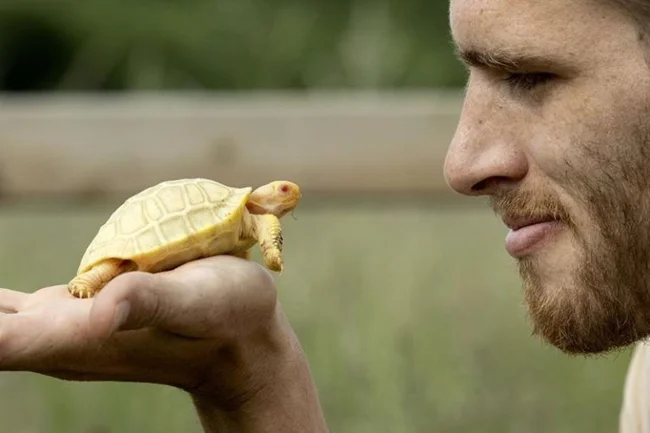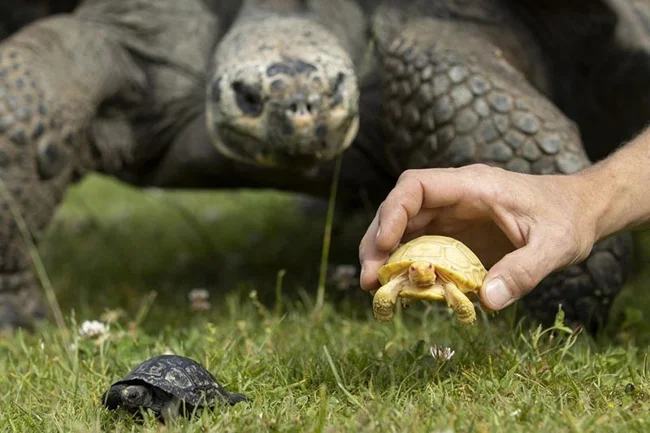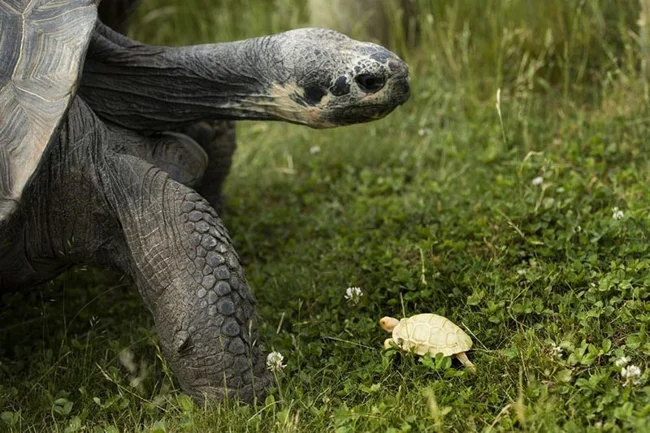Just the other day, the world was shown an extremely rare white baby turtle. The tiny red-eyed reptile has pigmentless skin and a pale carapace caused by a genetic disorder known as albinism. Zookeepers say the chance of an albino turtle being born is 1 in 100,000. 
The white tortoise is one of two Galapagos giant tortoises (Chelonoidis niger) that recently hatched at the Tropiquarium Zoo in Servion, Switzerland. A pair of eggs was laid on February 11 by a 220 lb (100 kg) female; The albino cub hatched on May 1st, and its darker brother was born on May 5th. Each baby turtle weighed just 1.8 ounces (50 grams) at birth and was initially cared for in incubators by zookeepers before being given the little creatures in a stronger state to their mother on June 3. 
“We were surprised to discover an albino cub,” zoo officials said in a statement. “This is the first time in the world that an albino Galapagos tortoise has been born in captivity.”
They also added that there are no documented cases that would confirm that something similar happened in the wild. The team also suggested that the birth of a white tortoise may be five times less common than the birth of an albino human, which is about 1 in 20,000 people, according to the National Organization for Albinism and Hypopigmentation, a nonprofit that provides information and resources about albinism. people in the USA and Canada. 
Albino animals are unable to produce the skin pigment known as melanin, which gives color to the skin, hair, eyes and feathers, and in this case, the turtle's shell. Albino animals are often born with red eyes because their eyes have no pigment, so they are the same color as the blood vessels under the surface of the eyes.
Albinism is a genetic disease, that is, it is transmitted from parents to offspring. However, this is a recessive trait, so both parents must have a copy of the gene and pass it on. If the parents have only one copy of the albino gene (unless they are albinos), the cubs appear with the typical color of the animal. 
It is currently unclear how long the albino cub will be able to live. Galapagos giant tortoises are the largest tortoises on Earth and can live in the wild for over 100 years. However, albinism can make animals more susceptible to damage from the sun's ultraviolet rays and prone to other health complications, such as decreased vision and hearing problems. It also makes the animals, which are usually much darker, more visible to predators. This means that animals with albinism often do not live very long and die before they can pass on their genes, which explains why the condition is so rare. But if they are properly cared for in captivity, they can live relatively healthy lives.
Breeding Galapagos giant tortoises in captivity can be challenging. The mating rituals of these huge reptiles can be quite aggressive: the males use their own shells to repeatedly ram the shells of the females and sometimes bite their paws before mounting them. During mating, males also make very loud and deep moaning sounds, it is these sounds that became the prototype for the roar of dragons in the popular show “Game of Thrones”. 
Like most reptiles, the sex of Galapagos giant tortoises is determined by the temperature at which the eggs are incubated. In this species, warmer conditions cause turtles to become females, while cooler temperatures produce males, according to the San Diego Zoo. According to Reuters, the sex of the new pair of hatchlings is unknown because there are no physical differences between males and females at this age.
Zoos are the only places where you can see baby Galapagos tortoises (both albino and regular). In the wild, hatchlings simply “disappear”, reappearing around 5 years of age. Researchers aren't entirely sure where the hatchlings go, but they suspect that the young tortoises spend their first few years hiding in the forest undergrowth to avoid their only natural predator, the Galapagos hawk (Buteo galapagoensis), according to the Zoological Society of London. (ZSL). No one knows exactly how the tiny turtles spend these years, but when the creatures reappear, they already appear large enough to be carried off by birds of prey, ZSL notes. 
Captive breeding in zoos is a very important tool for the conservation of these massive turtles, of which there are too few left in the wild. The population of wild tortoises in the Galapagos Islands was severely impacted by early European explorers, whalers, and naval crews who hunted the tortoises as a source of oil and food during their long voyages across the seas. Scientists believe that the Galápagos Islands were once home to about 200,000 giant tortoises, named after tortoises (the word "Galápagos" comes from an archaic Spanish word meaning "turtle"), but there are now only about 15 thousand.
Experts also believe that warmer temperatures caused by climate change could skew the sex ratio of hatchling turtles, which could affect their future reproduction in the wild. (If more babies are born to females, there will be fewer males to mate with, reducing genetic diversity in wild populations.)
0 comments
